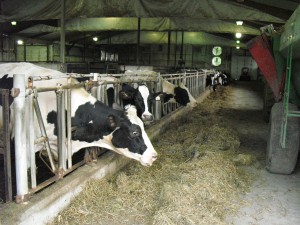I’d like to start off this blogging series with a dirty joke.
What’s black, white, and bred over and over? A Holstein dairy cow! Actually, the real dirty part of the joke is that they never stop pooping. For those of you with dairy experience this may have been your first answer, but before my internship started I’ll admit I may have answered with something lame like a penguin or perhaps a zebra. However, after completing my first week at Van Ryssel Dairy farm it is plain to see that the first image that comes to mind is a barn full of Holsteins, without a doubt. Located just outside of Oakbank, Manitoba, Canada Van Ryssel Dairy milks about 125 Holstein cows and farms 4000 acres.
I began my week by quickly becoming acquainted with the “girls” and getting a whorl wind, quick n’ dirty (literally and figuratively) walk through the barn chores. There are so many little tricks to remember for things like maneuvering the mechanized straw cart at just the right angles to prevent it from crashing while bedding the stalls or remembering who gets fed what and how much during feeding-all of which has to be carefully timed between the two daily milking times. But, for the majority of my internship, I will be dealing with the heifer and calf management and treating sick cows when necessary.
Fortunately for me, my first day on the job was also the day for “herd health” checks, which occurs once every two weeks. As an aspiring pre-vet, it was an amazing experience to go around with my supervisor, Peter and the two local vets who conducted the checks. So much so, that I plan on dedicating an entire blog in the future about herd health.
One of the major issues the diary industry faces is lameness, particularly in the legs and hooves of the cows. Basically, the happier the cow, the more milk it will produce. To prevent hoof infections from arising, the cows are run through a chute where I was shown how their hooves are trimmed and checked for ulcers, foot rot, and warts. Those cows with any problems with their feet are treated appropriately, and in the case of bacterial infections they are often treated with an intramuscular injection of Depocillin.
In my first week, I was shown how to “dry off” a cow to stop it from continuing to milk. This involves injecting OrbeSeal and medicated Dry-Clox into each of the four teats, followed by a final dip of iodine to prevent infection. At this time the feet or head of the developing fetus can be felt inside the cow through rectal palpation.
Occasionally, calves will get scours (a nasty diarrhea) that can be caused by a variety of reasons such as nutritional problems, bacteria (commonly E. coli), stress, or from something in the environment. To treat them, two pills of Neo-Sulfalyte are administered orally for about a 100 lbs. calf for a few days. Now, you have to realize that a calf is not going to simply swallow the pill on command, so a long rod is used place the pills down their throat.
In every case of treatment, it is extremely important to note and record the withdrawal time associated with each drug administered to each animal. When given certain drugs, for example the Depocillin mentioned above, the milk or meat of that animal is not allowed to become food until the withdrawal time indicated on the label is surpassed.
Dairy cattle are also susceptible to becoming bloated, which is basically an accumulation of gas in their digestive tract that continues to build up and expand until the animal becomes noticeably larger in size in the mid section and clearly uncomfortable. It doesn’t happen often, but bloat can be caused from eating high grain diets. This can be potentially fatal when not treated. To alleviate the gas build up, we placed a long hollow tube in the heifer’s mouth and down the digestive tract. Once the tube is placed all the way in, two people can apply pressure on either side of the animal and force the air out. Within seconds, the air is removed and the heifer returns to normal size. How is that for a weight loss program!
Now when I get home from the dairy and open the fridge, I have a new appreciation for the time and energy that goes into the milk I’m pouring into my glass and I’ll confess, into the freezer as well, for those of you that are familiar with my love of ice cream. So until next time, I’ll be upgrading my straw cart driving skills and getting my hands dirty.








Sam!
Welcome to blogging and what a rock star start! I was so proud, interested, and excited to read your first post. Keep up the great work, looks like you’re learning a lot. LOVE that picture of you!!